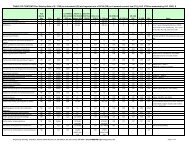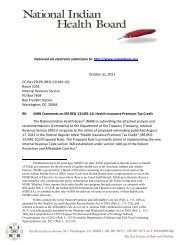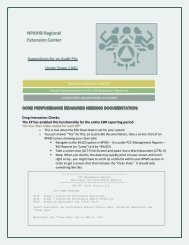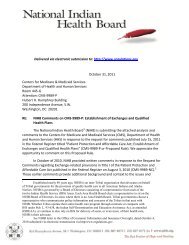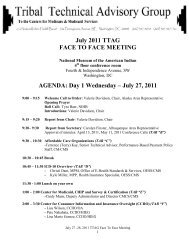mmpc - National Indian Health Board
mmpc - National Indian Health Board
mmpc - National Indian Health Board
Create successful ePaper yourself
Turn your PDF publications into a flip-book with our unique Google optimized e-Paper software.
Draft Report: Currently being circulated for Tribal leader and health director<br />
review and comment. Please provide comments by October 30, 2012 to Liz<br />
Heintzman at the <strong>National</strong> <strong>Indian</strong> <strong>Health</strong> <strong>Board</strong> at EHeintzman@nihb.org.<br />
Taken together, this complex healthcare delivery system is often referred to as the “I/T/U”<br />
(IHS/Tribal/Urban) or <strong>Indian</strong> healthcare system. A year later, the Congress authorized IHS and tribal<br />
health programs to bill Medicare and Medicaid, which expanded the resources available to them to<br />
carry out the federal trust responsibility.<br />
Today the <strong>Indian</strong> healthcare system includes 46 <strong>Indian</strong> hospitals (1/3 of which are tribally operated) and<br />
nearly 630 <strong>Indian</strong> health centers, clinics, and health stations (80 percent of which are tribally operated).<br />
When specialized services are not available at these sites, health services are purchased from public and<br />
private providers through the IHS-funded Contract <strong>Health</strong> Services (CHS) program. Additionally, 34<br />
urban programs offer services ranging from community health to comprehensive primary care.<br />
The I/T/U utilizes a community-based public health model with many approaches that are not found in<br />
typical American medical delivery systems. For example, the <strong>Indian</strong> health programs include public<br />
health nursing, outreach workers, prevention services, and even building community water and<br />
sanitation services. <strong>Indian</strong> health programs have pioneered new types of providers, such as community<br />
health aides and dental health therapists, as well as new approaches to delivering services in remote<br />
rural areas, including telehealth. Tribal governments manage a wide range of services, such as<br />
substance abuse treatment, the U.S.D.A. nutrition programs for pregnant women, infants and children<br />
(WIC), Senior Centers and elder nutrition sites, rabies vaccinations for dogs, and injury prevention<br />
programs, to name just a few. Tribal programs tend to take a more holistic view and utilize indigenous<br />
people who speak the local language and live in remote Tribal communities.<br />
Not only does the <strong>Indian</strong> health system have to deal with health disparities, it’s important to note that<br />
the system is also challenged with funding disparities. The IHS Federal Disparity Index (FDI) is used to<br />
determine the level of funding for the <strong>Indian</strong> health system relative to its total need. The FDI compares<br />
actual health care costs for an IHS beneficiary to those costs of a beneficiary served in mainstream<br />
America. The FDI uses actuarial methods that control for age, sex, and health status to price health<br />
benefits for <strong>Indian</strong> people using the Federal Employee <strong>Health</strong> Benefits (FEHB) plan, which is then used to<br />
make per capita health expenditure comparisons. Based on this model it is estimated that Congress<br />
provides direct appropriations to the <strong>Indian</strong> health system, on average, at approximately 60 percent of<br />
its level of need. 3 It is these health and funding disparities that exacerbate the challenges in providing<br />
health care for AI/AN people.<br />
3 The IHS calculates funding needs for IHS and tribal health programs by “comparing [IHS] funding to the cost of<br />
providing medical insurance for [AI/AN] users in a mainstream health insurance plan such as the Federal<br />
Employees <strong>Health</strong> Plan (FEHP).” <strong>Indian</strong> <strong>Health</strong> Manual, Part 6, Chapter 4, Manual Exhibit 6-4-A. This methodology<br />
is commonly referred to as the Federal Disparity Index (FDI). Available at:<br />
http://www.ihs.gov/NonMedicalPrograms/lnf/<br />
7





